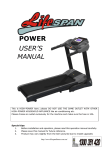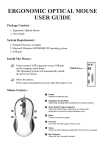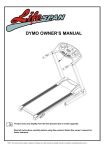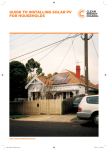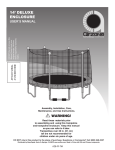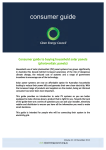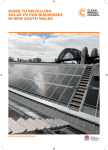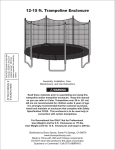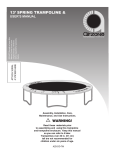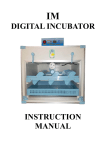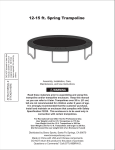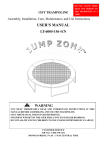Download classic spring trampoline
Transcript
SPRING TRAMPOLINE OWNER’S MANUAL Product may vary slightly from the item pictured due to model upgrades Read all instructions carefully before using this product. Retain this owner’s manual for future reference. TABLE OF CONTENTS 1. TECHNICAL DATA 3 2. GENERAL SAFETY INSTRUCTIONS 5 2.1 PURPOSE 5 2.2 DANGER FOR CHILDREN 5 2.3 RISK OF INJURIES 5 2.4 PRODUCT DAMAGE 6 2.5 ASSEMBLY ADVICE 6 3. SAFETY INSTRUCTIONS FOR TRAMPOLINES 8 2.6 ACCIDENT CATEGORIES 12 2.7 METHODS OF ACCIDENT PREVENTION 14 4. PARTS LIST AND ASSEMBLY INSTRUCTIONS 15 5. SAFETY NET 18 5.1 ASSEMBLY AND INSTALLATION INSTRUCTIONS 20 5.1.1 PACKAGE CONTENTS 21 5.1.2 DIAGRAMS FOR PARTS 21 5.1.3 INSTRUCTIONS 22 5.2 SAFETY NET CARE AND MAINTENANCE INSTRUCTIONS 25 5.3 SAFETY NEY USE INSTRUCTIONS 26 6. IMPORTANT ADVICE FOR USAGE 28 7. EXERCISE INSTRUCTIONS 30 2 SPRING TRAMPOLINE 8. MAINTENANCE 32 9. CLEANING 32 10. DISPOSAL ADVICE 32 11. WARRANTY REGISTRATION 33 3 SPRING TRAMPOLINE 1. TECHNICAL DATA Specifications of the product Model 8’ 10’ 12’ 13’ 14’ 16’ Size 244 cm 304 cm 366 cm 396 cm 426 cm 487 cm Height 65 cm 70 cm 86 cm 86 cm 89 cm 96 cm 199 cm 251 cm 316 cm 343 cm 373 cm 435 cm Jumping mat Teile Nr. 8’ 10’ 12’ 13’ 14’ 16’ Frame cover A 1 1 1 1 1 1 Jumping mat B 1 1 1 1 1 1 Top rail C 6 6 8 8 10 12 Spring D 48 60 72 80 90 108 Leg extension E&F 6 6 8 8 10 12 W-shaped leg G 3 3 4 4 5 6 Screw H 18 18 24 24 30 36 Tool I 1 1 1 1 1 1 4 SPRING TRAMPOLINE 2. GENERAL SAFETY INSTRUCTIONS 2.1. PURPOSE The product is intended for home/domestic use only and is not suitable for professional or medical use. 2.2. DANGER FOR CHILDREN WARNING! Trampolines over 51cm (20 inches) in height are not recommended for children under six years of age. Children do not recognize potential dangers from this product. Keep children away from this product. It is not a toy. The product has to be stored out of reach of children and pets. Do not let children unsupervised near this product. Carry out the suitable settings in the product by yourself and supervise the activity. Be aware that the packaging material is not suitable for children. There is danger of suffocation! 2.3. RISK OF INJURIES Do not use the product if it is damaged or defective. In this case, please consult a qualified technician or our service center. Check the product before every use. Defective parts must be changed immediately as they can impair the function and the safety of the product. Make sure that no more than one person is using the product at the same time. Use the product only on even and non-slipping surfaces. Never use it near water and keep sufficient space around it to increase security. 5 SPRING TRAMPOLINE Beware of moving parts, which could catch your arms and legs. Do not stick any objects in the product’s openings. 2.4. ATTENTION – PRODUCT DAMAGE Please do not alter the product. Only use original spare parts. Qualified technicians should only carry out repairs – improper repairs can lead to danger for the user. Use this product only as described in this manual. Protect the product against splashes, humidity, high temperature and direct sunlight. 2.5. ASSEMBLY ADVICE The assembly of the product must be done carefully and by three able-bodied adults. If in any doubt, ask a technically qualified person. Before you start with the assembly, read the instructions carefully and take a look at the assembly instructions. Remove all packaging materials and lay down all parts on a free space. This gives you an overview and simplifies the assembly procedure. Now, check with the parts list that no part is missing. Dispose of the packaging material when the assembly is completed. Beware that when using tools or doing technical work, there is always a risk of injuries. Therefore assemble the product carefully. Create a danger free environment; for example, do not let tools lay around the workspace. Store the packaging material in a way that cannot cause any danger. Foils and plastic bags are dangerous for children (danger of suffocation)! 6 SPRING TRAMPOLINE After installing product according to the instruction manual, please make sure that all screws, bolts and nuts are correctly installed and tightened and that all joints are tightly fixed. A free space of at least 9.5 m is necessary above the trampoline. An appropriate free space must be kept between the trampoline and possible sources of danger, such as electric cables, Tree branches, Playing devices, Swimming pools and fences, The Trampoline must be set up properly before use. Never set up the trampoline in heavy rain, wind or storm conditions, especially lightning conditions. It is recommended that the trampoline be taken apart and stored in bad weather. The metal frame of the trampoline will conduct electricity. Lightning, extension cords and all electrical equipment must never be allowed to come in contact with the trampoline. The Trampoline must always be used in a well-lit area. Nothing must be placed under the trampoline. The Trampoline in the vicinity of other leisure devices and constructions must not be used. When assembling or disassembly, please use gloves to protect your hands. 7 SPRING TRAMPOLINE 3. SAFETY INSTRUCTIONS FOR TRAMPOLINES WARNING Do not land on the head or One person only at a time may neck. There is the danger use the trampoline. Children under of paralysis or death, even 6 years may use the trampoline if landing in the center of only under special supervision. the trampoline. Several persons jumping at the same time on the trampoline will No somersaults tries increase the danger of control should be attempted, in loss, collision or falling down. It order to avoid danger of a can lead to serious injuries head or neck landing. 8 SPRING TRAMPOLINE Do not use the trampoline without supervision, regardless of age and experience. The safety instructions of the trampoline should always be considered and obeyed. During the use of the trampoline, there is a heavy danger of injury including permanent injuries such as paralysis, or even death. Even landings on the trampoline can lead to injuries, particularly to the back, neck or head. Somersaults must be avoided. In any case, only one person should use the Trampoline at a time. Neither the importer, the shops nor our manufacturers and suppliers will be responsible or liable in any form for direct, indirect or special damages caused during the use or in connection with it. This also applies to financial losses by theft, property loss, loss of earnings/services and profit, loss of satisfaction in the device, costs of the installation, disposal, damage by influences of the weather and environment as well as any other kinds of damages. Recognizable production defects are announced immediately by the dealer or manufacturer/ importer and shall be adjusted immediately for further use. The buyer/Operator of the trampoline has to examine the device regularly on wears or damage. No clothes with hooks or parts may be carried when jumping on the trampoline, in order to avoid hooks getting caught. The trampoline may be set up only on a flat ground. Strong winds can blow the Trampoline away. If strong winds are predicted, the Trampoline must be moved to a protected place, and taken apart, or fastened to the ground with cords and herrings. At least three anchorages are necessary. It is not enough to anchor the pennants in the ground since they can tear out of the patch cords. 9 SPRING TRAMPOLINE Try to avoid the moving the assembled trampoline, because it could bend during transportation. Should it be necessary to move the trampoline, please consider the following: 1.) At least four people must be evenly spaced around the frame to lift the trampoline off the ground 2.) The trampoline must be carried horizontally 3.) Be careful while moving, because the frame could bend. If this happened, use four people to draw the trampoline in shape. Trampolines are jumping devices, enabling the user to jump into unusual heights as well as into a multiplicity of body movements. Jumping in the Trampoline, hitting the frame, cushioning or incorrect landing on the Trampoline can lead to injuries. All users must read the recommendations of the manufacturer themselves to ensure they use the device correctly. Users should be familiar with the assembly manual. This manual contains assembly guidance; selected precautionary measures as well as recommendations for servicing and maintenance of the trampoline, in order to ensure a secured and fun use of the Trampoline. It is the responsibility of the owner or the supervisor to guarantee that all users of the trampoline are informed sufficiently of all warning references and safety instructions. 10 SPRING TRAMPOLINE For the supervisor: The supervisor’s role is to make sure the users know all the safety rules as well as learn the basic, fundamental bounces. They need to enforce all the safety rules and warnings in the manual, frame and labels. When a supervisor is not available, the trampoline may be disassembled or covered to limit access. It is the supervisor’s responsibility that the placard with the Trampoline Safety Tips is placed where all jumpers are informed about the tips. Implement all safety rules and make yourselves familiar with the information in the user manual. All users of the trampoline need a supervisor, regardless of the age and the experience of the user. Do not recommend this trampoline for children under 6 years of age. The trampoline can be only used, if the jumping mat is clean and dry. Worn or damaged jumping mats should immediately be replaced. Objects, which could be dangerous to the user, should be away from the trampoline Avoid unauthorized and unsupervised use of the trampoline. Do not use the Trampoline under influence of alcohol or drugs (incl. medicines). Learn the fundamental jump and body positions carefully, before trying difficult jumps. Stop jumping by bending your knees when your feet come to contact with the trampoline. The skill of braking should be used whenever you lose balance or control from a previous maneuver. Loss of balance or control will increase the risk of injury from landing on the frame, springs or completely off the trampoline. A controlled jump is considered landing on the same spot that you took off from .If you do lose control when you are jumping on the trampoline, bend your knees sharply when you land and this will allow you to regain control and stop your jump. 11 SPRING TRAMPOLINE Climb onto the trampoline. Do not jump on it directly. Do not use the trampoline as jumping board for other articles. 2.6. ACCIDENT CATEGORIES Somersaults: A landing on the head or neck increases the risk of neck and back injuries, which can lead to paralysis and sometimes death. This can occur if the user makes an error and falls forward or backward. No somersaults should be attempted on the trampoline. The probability of an injury increases if more than one person is jumping on trampoline. Users can collide, fall off the trampoline, land improperly on the jumping mat and on each other. Smaller users will more easily be hurt in this case. Climbing on or off the trampoline: The trampoline’s jumping mat is approximately one meter above the ground. Jumping off the trampoline onto the ground or another surface can lead to an injury. Jumping onto the trampoline from a building roof, a terrace or other objects can lead to injury. Small children need assistance when climbing on or off the trampoline. Be careful when climbing on and off the trampoline. Do not step on the cushioning or the framework. Do not use the framework for climbing on or off the trampoline. Hitting the framework or the springs: When playing on the trampoline, stay in the center of the mat. This will reduce your risk of getting injured by landing on the frame of springs. Always keep the frame pad covering the frame of the trampoline. DO NOT jump or step onto the frame pad directly since it is not intended to support the weight of a person. 12 SPRING TRAMPOLINE Loss of control: when users lose control of their jump, they can land wrongly on the jump mat, land on the framework or the cushioning or fall down from the Trampoline. A controlled jump is one where the jumper lands and jumps from the same spot. Before a more difficult jump maneuver is practiced, the basic controlled jump should be mastered perfectly and continuously. If a jump maneuvers is attempted, which exceeds the abilities of the jumper; there is a danger of losing control. In order to regain control of the jump and land correctly, knees should be completely bent upon landing. Under influence of drugs or alcohol: The probability of an injury rises if the user is under the influence of alcohol or drugs. These substances weaken the response, the faculty of judgment, the space awareness, the co-ordination and the motor functions of the user. Collision with objects: while using the trampoline, person, animals or articles under it will increase the probability of an injury. Jumping on the trampoline while carrying an article, increases the probability of an injury. Placing the trampoline too close to electric wires, tree branches or other obstacles will increase the probability of an injury. Bad maintenance of the Trampoline: Users can hurt themselves if the trampoline is in bad condition. A torn jumping mat, bent framework, missing cushioning or missing framework must be replaced before using the trampoline again. The trampoline should be examined before each use. Weather conditions: A wet jumping mat is too slippery for safe jumping. Gusty or strong winds can lead to a loss of jump control when jumping. In order to lower the probability of an injury, the trampoline should be used under suitable weather conditions only. 13 SPRING TRAMPOLINE 2.7. METHODS OF ACCIDENT PREVENTION Role of the user in preventing accidents: A basic knowledge of the trampoline by the user is a must for security. All users of the trampoline must learn first how to accomplish a low controlled jump as well as the fundamental landing positions and combinations, before turning to advance jump exercises. Users must know why they must control their jump, before they may practice other movements. A controlled jump is when you land and take off from the same location. The first lesson is the understanding of the correct order in developing jumping skills on a Trampoline. For further information or exercise materials, please turn to a trained Trampoline teacher. Role of the supervisor in preventing accidents: It lies in the responsibility of the supervisors to guarantee a reasonable and experienced supervision of the users of trampoline. Rules and warnings in this manual must be applied, and known to the users of the trampoline in order to reduce the probability of accidents and injuries. In times, when the supervision is not possible or insufficient, the trampoline should be dismantled and stored in a secured place against unauthorized use. 14 SPRING TRAMPOLINE 4. PARTS LIST AND ASSEMBLY INSTRUCTIONS PARTS Frame Cover ITEM A Jumping Mat B Top Rail C Metal Clips D Leg Extension E Leg Extension F W-Shaped Leg G Screw H Tools I Frame Cover A Jumping Mat B ) D C Springs ) Top Rail H E Leg Extension Screw I G Tools W-Shaped Leg Piece 15 SPRING TRAMPOLINE FRAME ASSEMBLY Refer to PARTS LIST for identification of parts. Lay out all trampoline parts in groups (Just like the picture). Begin by attaching two leg extensions to assemble one “W” shape leg with rail screws. Continue until you form a large circle. Joining the last link may require two or more adults in good physical condition. With a second person holding the opposite end, bring both sides of the circle firmly together and make them secured. Attach the “W” leg assembly to the top frame. This is the KEY step: top rail B (short one, without welded tubes) must be placed firmly inside “W” leg assembly, that’s very important (just like picture). Attach the leg assemblies making all secured. Attach the “W” leg to the top frame and secure with rail screws. 16 SPRING TRAMPOLINE Now the frame assembly is complete. MAT & COVER ASSEMBLY With stitching portion facing down, lay jumping mat inside frame and attach a spring into one of the triangle rings on the mat. Then attach spring with ring to frame. WARNING: Trampoline is under heavy tension, more effort may be required to attach springs to frame. Be careful not to pinch fingers or slip. Serious injury may occur. Repeat this step directly across from where you attached first spring. Then attach two more springs half distance between the first two, directly across from each other. Use spring tool as shown. Springs under heavy tension may require adjacent springs to be attached every four or five holes, making the springs tension averagely distributed. Attach remaining springs until all springs are placed on frame securely. Lay blue frame cover on outer edge so springs are covered- just like a shower cap. Tie all black straps to top rail of frame. Do not tie to springs. That’s it! Your trampoline is complete! To disassemble repeat steps 1-15 in reverse. 17 SPRING TRAMPOLINE 5. SAFETY NET Liability While every attempt is made to embody the highest degree of protection in all equipment, we cannot guarantee freedom from injury. The user assumes all risk of injury due to use. All merchandise is sold on this condition, which no representative of the company can waive or change. WARNING: In addition to the instructions and precautions provided with your trampoline, the following precautions must be observed while using the Trampoline Safety Enclosure. The metal frame of the trampoline enclosure will conduct electricity. Lights, extension cords, and all such electrical equipment must never be allowed to come in contact with the enclosure. Inspect the enclosure before each use. Make sure the straps and all parts are correctly and securely positioned and attached. Tighten any loose hardware. Replace any worn, defective, or missing parts. Wear comfortable clothing free of hooks, snaps, drawstrings for anything which may snag or catch in the safety enclosure mesh, Remove jewelry, necklaces, and earrings. Climb on and off the trampoline only through the safety enclosure entrance and securely close entrance. Users, especially children, must not attempt to enter or exit between the trampoline frame and the enclosure. Doing this may pose a strangulation risk. 18 SPRING TRAMPOLINE WARNING: Do not touch or rebound off the safety enclosure mesh while using the trampoline. Read all instructions and complete all assembly before using the safety enclosure. Use trampoline and trampoline enclosure only with mature, knowledgeable supervision. For Recreational Use ONLY. Not for Professional Use. Weight Limit for Trampoline User is 100kgs (220lb). 19 SPRING TRAMPOLINE 5.1. ASSEMBLY AND INSTALLATION INSTRUCTIONS Adequate overhead clearance is essential. A minimum of 24 ft (7.3m) from ground level is recommended. Provide clearance for wires, tree limbs, and other possible hazards. Lateral clearance is essential. Place the trampoline and trampoline enclosure away from walls, structures, fences, and other play areas. Maintain a clear space on all sides of the trampoline and trampoline enclosure. A minimum of six feet from frame edge is recommended. The trampoline is heavy and is under heavy tension. Three able-bodied adults are required to set it up. Use appropriate clothing and shoes. Failure to follow these instructions may lead to injury or damage to the trampoline. Never set-up the trampoline in heavy rain, wind or storm conditions, especially lightning storms. It is recommended that the trampoline be taken apart and stored in bad weather. When moving the assembled trampoline, have at least four people evenly spaced around the frame (NSEW) to lift the trampoline off the ground. Place the trampoline and trampoline enclosure on a level surface before use. Use the trampoline and trampoline enclosure in a well-lit area. Artificial illumination may be required for indoor or shady areas. Secure the trampoline and trampoline enclosure against unauthorized and unsupervised use. Remove any obstructions from beneath the trampoline and trampoline enclosure. The owner and supervisors of the trampoline and trampoline enclosure are responsible to make all users aware of practices specified in the “Use Instructions”. The trampoline enclosure is only to be used as an enclosure for a trampoline and the trampoline must be of the appropriate size covered by the specific enclosure. 20 SPRING TRAMPOLINE 5.1.1. FIG. ASSEMBLY AND INSTALLATION INSTRUCTIONS PARTS NAME 16’ (6 Legs) 12’ 8’ /10‘ (4 Legs) (3 Legs) 14’ (5 Legs) 1 GALVANIZED PIPE 12 PCS 10PCS 8PCS 6PCS 2 GALVANIZED PIPE 12 PCS 10PCS 8PCS 6PCS 3 STEEL JIG 24 PCS 20PCS 16PCS 12PCS 4 SAFETY MESH 1PC 1PC 1PC 1CS 5 Tools 1PC 1PC 1PC 1CS 5.1.2. DIAGRAMS FOR PARTS 1. Galvanized Pipe 2. Galvanized Pipe 3. Steel Jig Assembly 4. Sefety Mesh WARNING: ONLY TO BE ASSEMBLED BY AN ADULT. READ AND FOLLOW THESE INSTRUCTIONS PRIOR TO ASSEMBLY AND USE OF EQUIPMENT. 21 SPRING TRAMPOLINE 5.1.3. INSTRUCTIONS STEP 1: Spread the safety mesh out flat onto the trampoline mat as shows on Figure 1. Place two sections of support pipes together an connect them as shown in Figure 2. FIGURE 2 FIGURE 1 STEP 2: Insert support pipes into the sleeves of the safety mesh in order, as show in Figure 3. FIGURE 3 22 SPRING TRAMPOLINE STEP 3: Erect the support pipes corresponding to each trampoline leg in an orderly manner. As shown in Figure 4. FIGURE 4 STEP 4: Fix the support pipes onto the trampoline legs using 2 Steel Jigs as shown in Figure 5. Place the plastic cap onto the Steel Jig after it has been fastened to the leg. FIGURE 5 23 SPRING TRAMPOLINE STEP 5: Use the hook to attach the triangular rings on the trampoline mat to the frame as shown in figure 6. FIGURE 6 24 SPRING TRAMPOLINE 5.2. SAFETY NET CARE AND MAINTENANCE INSTRUCTIONS Inspect the trampoline and trampoline enclosure before each use and replace any worn, defective, or missing parts. The following conditions could represent potential hazards: 1. Missing, improperly positioned, or insecurely attached frame padding, barrier or enclosure support system (frame) padding and pole caps. 2. Punctures, frays, tears, or holes worn in the bed or frame padding, barrier or enclosure support system (frame) padding and pole caps. 3. Deterioration in the stitching or fabric of the bed or frame padding, barrier or enclosure support system (frame) padding and pole caps. 4. Ruptured springs or bands. 5. A bent or broken frame or support system. 6. A sagging barrier or bed. 7. Sharp protrusions on the support (frame) or suspension system. 8. Loosened or missing hardware. 25 SPRING TRAMPOLINE 5.3. SAFETY NET USE INSTRUCTIONS Do not allow more than one person on the trampoline or inside the trampoline enclosure. Use by more than one person at the same time can result in serious injuries. Use trampoline and trampoline enclosure only with mature, knowledgeable supervision. Trampolines over 20 inches (51cm) tall are not recommended for use by children under six years of age. Never set-up the trampoline in heavy rain, wind or storm conditions, especially lightning storms. It is recommended that the trampoline be taken apart and stored in bad weather. When moving the assembled trampoline and trampoline enclosure have at least four people evenly spaced around the frame (NSEW) to lift the trampoline off the ground. Inspect that trampoline and trampoline enclosure before each use. Make sure that frame cover, barrier and, enclosure support padding are correctly and securely positioned. Replace any worn, defective, or missing parts. The metal frame of the trampoline will conduct electricity. Lights, extension cords, and all such electrical equipment must never be allowed to come in contact with the trampoline. Wear comfortable clothing. Remove jewelry, necklaces, and earrings. Wear clothing free of draw strings, hooks, loops or anything that could get caught in the barrier. Enter and exit the enclosure only at the enclosure door or barrier opening designated for that purpose. It is a dangerous practice to jump from the trampoline to the ground or floor when dismounting, or to jump onto the trampoline when mounting. Do not use trampoline as a springboard to other objects. Avoid bouncing too high. Stay low until bounce control and repeated landing in the center of the trampoline can be accomplished. Control is more important than height. Properly secure the trampoline when not in use. Protect it against unauthorized use. If a trampoline ladder is used, the supervisor should remove it from the trampoline when 26 SPRING TRAMPOLINE leaving the area to prevent unsupervised access by children under six years of age. For additional information concerning the trampoline equipment, contact the manufacturer. Read all instructions before using the trampoline and trampoline enclosure. Warnings and instructions for the care, maintenance, and use of this trampoline and trampoline enclosure are included to promote safe, enjoyable use of this equipment. Do not intentionally bounce off the barrier. Do not attempt to jump over barrier or attempt to crawl under barrier. Do not hang from, kick, cut or climb on barrier. Do not attach anything to the barrier that is not manufacturer approved accessory or part of the enclosure system. 27 SPRING TRAMPOLINE 6. IMPORTANT ADVICE FOR USAGE The jumper must first learn all of the basic, fundamental bounces before attempting more difficult ones. Low, controlled bounces are a good start before learning the basic landing positions and combinations. Jumpers need to understand that control is the key to a successful jump. Review of the users’ manual to learn basic technique is a must. Following the tips in the placard is also important. Contact a certified trampoline instructor for more information. In the learning phase, users must practice and perfect these basic techniques. The deceleration or examining of the jump must be informed first and emphasized as a security measure. Users must break their jump, as soon as they begin to lose the balance or lose control of their jump. Bending the knees on landing so as to absorb the energy of the jump does this. Thus users can stop the jump immediately and avoid control loss. A better, more controlled jump for the trampoline is one in which the user lands on the original jumping place. This exercise is learned only if users can repeat it regularly. Users may never turn to a more difficult exercise before having mastered all the previously learned exercises. Users should have a respectively short jumping time. Jumping for too long exposes the user to an increased danger of injury. Longer jumping periods also reduce the interest of the other users, as they have to wait for their turn to jump. The clothes must consist of a t-Shirt, short trousers, Gymnastic shoes and thick socks (can also be barefoot). Beginners should wear appropriate protective clothing, like long arm shirts and training trousers, until they can control the landings correctly. Thus, 28 SPRING TRAMPOLINE scratches are prevented by wrong landing on the elbows and knees. No firm shoes may be carried, since they lead to strong wear of the Trampoline. For correct climbing on and off the trampoline, a firm rule must be followed by beginning users: They should always use their hand on the framework and use this to climb up or down, then stand on the jumping mat. When the ascending and descending off the trampoline does not rise directly on the framework or seize the framework. To descend, users have to go to the exterior of the jump mat, bend forwards and put their hands on the framework, then step from the mat to the ground. DO NOT dismount by jumping off the trampoline and landing on the ground, regardless of the makeup of the ground. If small children are playing on the trampoline, they may need help in mounting and dismounting. Daring jumps are not recommended. All skills should be learned with normal jumps. The control of the jump and not the height are to be emphasized. User may not jump alone and unsupervised on the Trampoline. 29 SPRING TRAMPOLINE 7. EXERCISE INSTRUCTIONS F U N D AM E N TAL B O U N C E S KNEE BOUNCE STANDING BOUNCE 1. First, assume kneeling position in center of bed, back straight, eyes on end of bed. 2. Pump your way to your feet by bouncing, using your arms as in standing bounce. 1. Start in the center of bed, feet shoulderwidth apart, arms at side, eyes on end of bed. 3. Duplicate position from a low bounce 2. As you jump from trampoline, arms come up and forward, circling outward and back To side as you again contact bed. Bring feet together, toes pointed, in the air, feet Shoulders-width apart again as you contact bed. Arms need never go above your shoulders or behind your body. HANDS & KNEE DROP FRONT DROP 1. First, assume position shown in illustration, keeping head up, eyes on end of bed. 2. Duplicate position from a low bounce. Keep your hands as close to your knees as shown in illustration. 1. First, assume position of hands and knees bounce. Begin to bounce slightly in this position, then kick legs back, land on stomach, taking some weight on bent forearms as shown in illustration. Make sure you kick backwards, do not go forward, and return to hands and knees position. SEAT DROP 2. Try from a low bounce, kicking backwards, making your belt land where your feet were. 1. First, assume sitting position in center of bed, legs spread wide, and hands on bed, leaning slightly forward. 2. Duplicate this position from a low bounce. To come to your feet again, be sure to lean forward and press bed with your hands. 30 SPRING TRAMPOLINE BACK DROP PIROUETTE 1. Lie on your back on bed, spread your legs slightly and raise them about 45 degrees from the surface of the bed, raise your arms to corresponding angle, raise head and look at end of trampoline. This is your landing position. 2. HALF PIROUETTE: Done like a standing bounce, but at top of bounce, swiftly turn head and search for opposite end of trampoline. Do not travel. Land on feet. Try cautiously from a low bounce, making sure you do not lose sight of end bar of trampoline at any time. Weight should be taken more on your shoulders than on your hips. FULL PIROUETTE: Done as above, but continue around, until a complete circle has been made. Spot by looking for end bars as you complete trick. TUCK POSITION PIKE POSITION Done like a standing bounce, but at top of bounce, bring knees to chest and grasp with arms. Then lower feet to contact bed. Done like a standing bounce, but at top of bounce, keeping knees locked and toes pointed, raise legs as illustrated, then lower feet to contact bed. LAYOUT POSITION STRADDLE POSITION Done like pike bounce, but with legs spread as widely as is comfortable. Reach for your toes! Done like a standing bounce, but at top of bounce, stretch slightly, arching back, and momentarily looking skyward. 31 SPRING TRAMPOLINE 8. MAINTENANCE Assess the product regularly for damages or abrasion, and let authorized dealers handle it. If damages occur before the warranty expiry date, please ensure that you have retained your proof of purchase. 9. CLEANING Do not use any abrasive cleansers for the cleaning. Use a soft, damp cloth to eliminate dirt and dust. 10. DISPOSAL ADVICE Packaging: This product is delivered with a packaging, to protect it from damages during transport. The packaging materials are made of raw materials, which are recyclable. Please dispose of these materials according to material type. If you want to dispose of the products, dispose according to regulations in your area. Refer to your municipal institution for further information. 32 SPRING TRAMPOLINE 11. WARRANTY AUSTRALIAN CONSUMER LAW Many of our products come with a guarantee or warranty from the manufacturer. In addition, they come with guarantees that cannot be excluded under the Australian Consumer Law. You are entitled to a replacement or refund for a major failure and compensation for any other reasonably foreseeable loss or damage. You are entitled to have the goods repaired or replaced if the goods fail to be of acceptable quality and the failure does not amount to a major failure. Full details of your consumer rights may be found at www.consumerlaw.gov.au Please visit our website to view our full warranty terms and conditions: http://www.lifespanonline.com.au/Warranty-Policy 33 SPRING TRAMPOLINE

































